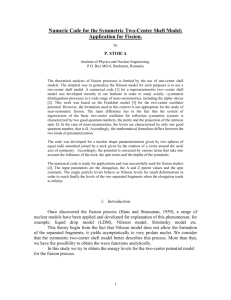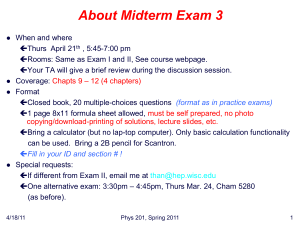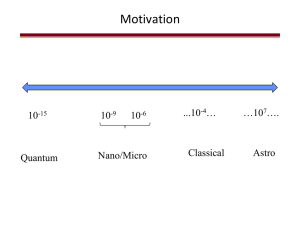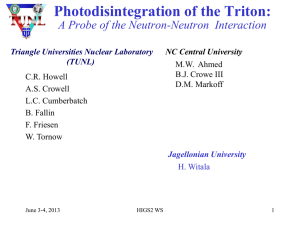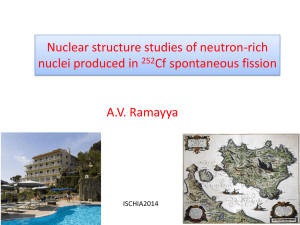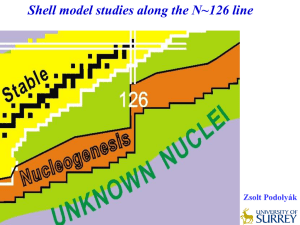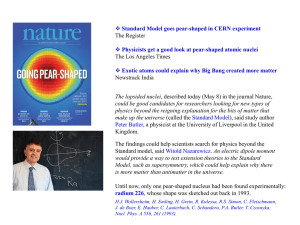PPT下载
advertisement
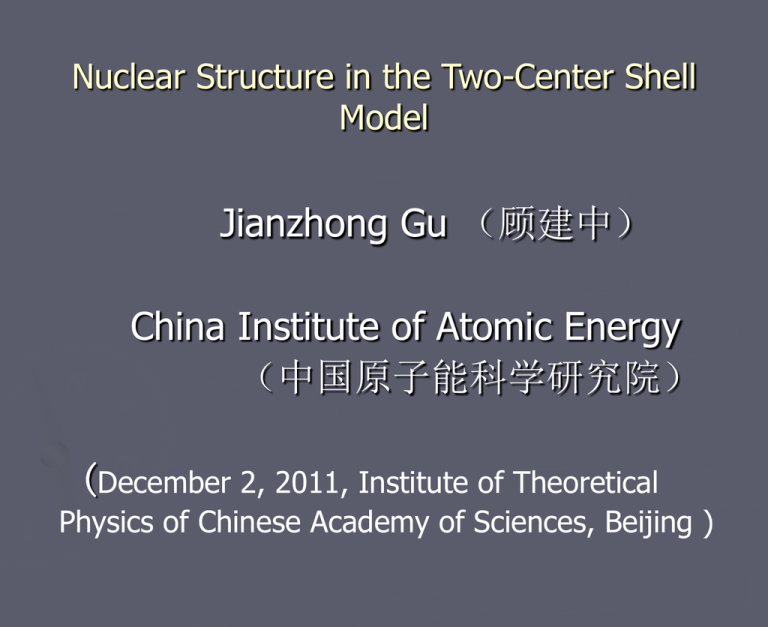
Nuclear Structure in the Two-Center Shell Model Jianzhong Gu (顾建中) China Institute of Atomic Energy (中国原子能科学研究院) (December 2, 2011, Institute of Theoretical Physics of Chinese Academy of Sciences, Beijing ) Outline 1 Introduction to Two-Center Shell Model 2 Structure Calculations Based on the TCSM 3 Outlook for the TCSM Study 1. Introduction to Two-Center Shell Model The background of the two-center shell model (TCSM) The TCSM was developed for nuclear large deformations including fission and fusion. U. Mosel and W. Greiner Z. Phys. 217 (1968) 256-281. They introduced asymmetric nuclear shapes in the investigation of the collective potential energy surface. Shell correction was proposed by V. M. Strutinsky ( Nucl. Phys. A 95 (1967) 420; 122 (1968) 1. ) Two-center shell model P. Holzer, U. Mosel and W. Greiner, Nucl. Phys. A 138 (1969) 241-252. D. Scharnweber, W. Greiner and U. Mosel, Nucl. Phys. A 164 (1971) 257-278. They extended the one-dimensional solutions by E. Merzbacher (Quntum Mechanics, P. 64-77, New York, Wiley 1961) to the solutions in three dimension. Two centers, but symmetric and having a potential cusp. J. Maruhn and W. Greiner, Z. Phys. 251 (1972) 431-457. They generalized the model to asymmetric shapes with a smooth joining of the fragments allowing a variable height of the potential barrier between the fragments. The justification of such a spin-orbit coupling can be found in Nucl. Phys. A 142 (1970) 72. The l2 term is retained as in Phys. Lett. B 35 (1971) 467. The TCSM can describe the scission point, which is its advantage over other mean field models. Extreme shapes allowed by the TCSM. 2. Structure Calculations Based on the TCSM h0= The neck is important for the Chaos. The two-center shell model serves an example Supporting the BGS conjecture. 3. Outlook for the TCSM Study Potential energy surfaces based on the TCSM. More realistic, e. g. TCSM with woods-Saxon potential. Experiments: for A=190 mass region, I=8-12 hbar at decay out points. Calculations: the barrier gets thin and low at such spins, and the decay out suddenly happens. Information for the excitation energies and spins at decay out points can be obtained, which is the most wanted for experiments. Bandheads here are taken from Eur. Phys. J. A 33 (2007) 237. A HFB approach based on the D1S Gogny force. Jianzhong Gu, Bangbao Peng, Wenhua Zou and Shuifa Shen, Nucl. Phys. A (in press). 我们系统计算了A=190质量区汞同位素原子核的位能曲面群。根据计算得到的位能曲面群, 用WKB方法计算了穿透宽度,得到了和有关实验数据相符的结果。 Tunneling width Γtunn (in units of eV) J 0 2 4 6 8 10 12 14 16 18 20 188Hg 190Hg 192Hg 194Hg 196Hg 753.2 684. 3 607.1 486. 397. 207. 180. 0 0 0 0 16.7 14.3 12.9 11.1 7.0 2.6 6.8E-5 1.7E-7 2.1E-9 6.7E-11 2.4E-12 47.2 46.5 31.0 30.0 15.40 2.0 6.6E-4 5.7E-4 9.1E-7 2.3E-8 4.6 E-11 3.2 2.4 1.9 1.1 0.48 0.33 0.13 2.4E-3 1.5E-6 3.8E-8 1.8E-9 0.74 0.58 0.44 0.27 0.12 0.075 0.027 0.011 0.0038 8.6E-6 1.4E-8 计算结果还表明: 超形变带的带外衰变与原子核的具体结构有关,对同位旋有很强的依赖性。于是,在国际 上首次将带外衰变问题的研究推到了微观水平。带外衰变是普遍存在的转动带之间耦合的一种。我们相 信位能曲面群方法为转动带之间耦合强度计算提供了一种微观方法,而且对其他多体问题也有用。 The sudden decay is mainly due to the barrier lowering, not the degree of the chaoticity, putting Aberg’s conclusion into question. 基于位能面群方法我们在国际上首次研 究了A≈80 区丰质子奇特原子核80,82,84Zr 的结构及其随形变和角动量(自旋)的 演化。这些原子核的质子数和中子数相 等或相近,其核结构极其复杂。80Zr还是 快质子俘获过程中重要的等待点核。 Wen-hua Zou, Yuan Tian, Jian-zhong Gu* et al., “Microscopic description of nuclear structure around 80Zr”, Phys. Rev. C 82 (2010) 024309. 发现80Zr和84Zr存在形状相变,这是由布居在1g9/2 轨道上的核子顺排驱动的。而82Zr存在强烈的形状 混杂,这源于单粒子运动与集体运动的剧烈竞争。 确定了它们的平衡形状,这些平衡形状的 四极形变值与实验值相符。由这些核的单粒子 谱结构可以理解它们的平衡形状和形状共存。 还发现在高自旋时, 分隔82Zr和84Zr这两个核的正常 形变转动带和超形变转动带的位垒随着自旋的升高 会变得越来越低而且窄,这预示着这两个核在高自 旋超形变状态下会发生跃迁到正常形变带的带外衰 变。与上述两原子核迥然不同,在高自旋情形下, 原子核80Zr的位垒又高又厚。因此,超形变带的带外 衰变不会发生在80Zr原子核。 In future, other mass regions, including super-Heavy Nuclei. Thank you very much for your attention! Stone Flower Cave, which is close to the CIAE

